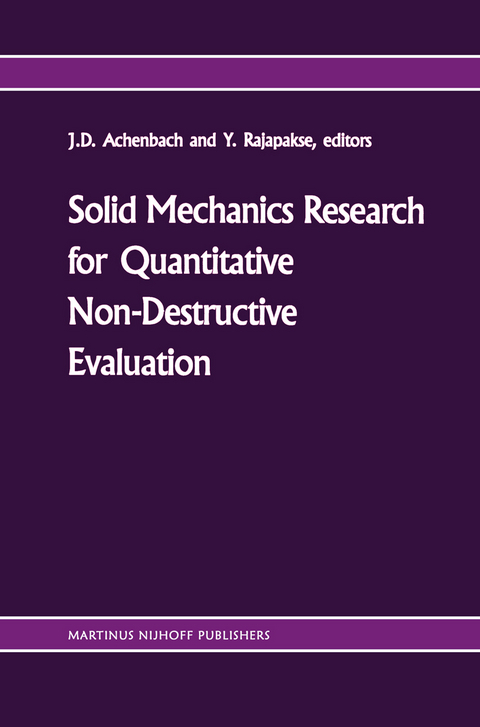
Solid mechanics research for quantitative non-destructive evaluation
Springer (Verlag)
978-94-010-8074-3 (ISBN)
1. DOD Interests in QNDE.- 1.1 Naval Ship System Requirements in Quantitative Nondestructive Evaluation.- 1.2 Air Force Requirements for NDE of Composites.- 2. Acoustic Emission.- 2.1 Acoustic Emmision: a Quantitative NDE Technique for The Study of Fracture.- 2.2 Applications of Quantitative AE Methods: Dynamic Fracture, Materials and Transducer Characterization.- 3. Defect Characterization by Scattering Methods.- 3.1 Flaw Characterization by Ultrasonic Scattering Methods.- 3.2 Experimental Research of Ultrasonic Scattering from Discontinuities.- 4. Fracture Mechanics and QNDE.- 4.1 Application of QNDE to Retirement-for-Cause Analysis.- 4.2 Elastic Wave Interactions with Partially Contacting Interfaces: Status of Theory and Application to Fatigue Crack Closure Characterization.- 4.3 Ultrasonic Nondestructive Evaluation, Microstructure and Fracture Toughness Interrelations.- 5. Acoustic Microscopy.- 5.1 Acoustic Microscopy of Surface Cracks: Theory and Practice.- 5.2 QNDE using Low-Frequency Acoustic Microscopy.- 6. Qnde of Composite Materials.- 6.1 Ultrasonic NDE of Composites — A Review.- 6.2 Nondestructive Characterization of Impact Damage in Graphite/Epoxy Laminates.- 6.3 Characterizing the Damage State of Composite Laminates VIA the Acousto-Ultrasonic Technique.- 7. Thermal Wave Imaging.- 7.1 Thermal Wave Imaging for Quantitative Nondestructive Evaluation.- 8. Qnde of Material Properties and Residual Stress States.- 8.1 Theory of Acoustoelasticity and Acoustoplasticity.- 8.2 Ultrasonic Measurement of Residual Stresses.- 8.3 Low-Field Magnetoacoustic Residual Stress Measurement in Steel.- 8.4 Ultrasonic Determination of Texture and Residual Stress in Polycrystalline Metals.- 9. Contributed Papers.- 9.1 Analytical Considerations for Inelastic Zone and Crack GrowthCharacterizations.- 9.2 A Comparison of Several Ultrasonic Techniques for Absolute Stress Determination in the Presence of Texture.- 9.3 Ultrasonic Scattering and NDE of Materials and Cracks.- 9.4 Hybrid Ray-Mode and Wavefront-Resonance Techniques for Acoustic Emission and Scattering in Multiwave Layered Media.- 9.5 Monitoring Elastic Stiffness Degradation in Graphite/Epoxy Composites.- 9.6 Mechanical Modeling and Measurements on Fibrous Composites.- 9.7 Acoustic Emission Source Characterization of Microcracking in A533b Steel.- 9.8 Diffuse Field Decay Rates for Material Characterization.- Epilogue They Met to Argue NDT.- List of Attendees.
| Zusatzinfo | XVI, 438 p. |
|---|---|
| Verlagsort | Dordrecht |
| Sprache | englisch |
| Maße | 155 x 235 mm |
| Themenwelt | Naturwissenschaften ► Physik / Astronomie ► Mechanik |
| Technik ► Maschinenbau | |
| ISBN-10 | 94-010-8074-7 / 9401080747 |
| ISBN-13 | 978-94-010-8074-3 / 9789401080743 |
| Zustand | Neuware |
| Haben Sie eine Frage zum Produkt? |
aus dem Bereich


